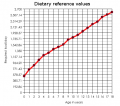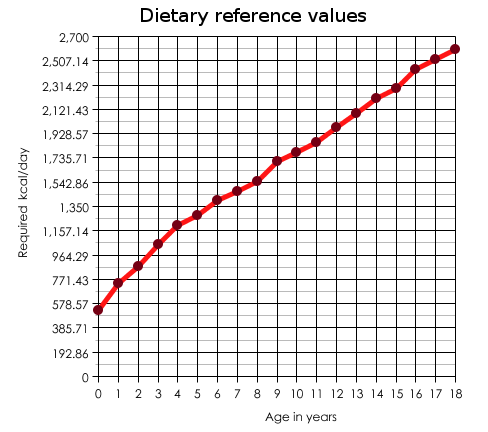Dietary_reference_values.png (488 × 432 pixels, file size: 28 KB, MIME type: image/png)
A schematic showing the daily energy requirements for a person (male or female) from age 0-18. Exact numbers follow:
Age in years -- kcal/d:
- 0 -- BMR:375 x PAL:1,40 = 525 TDEE
- 1 -- BMR:525 x PAL:1,40 = 735 TDEE
- 2 -- BMR:625 x PAL:1,40 = 875 TDEE
- 3 -- BMR:750 x PAL:1,45 = 1050 TDEE
- 4 -- BMR:825 x PAL:1,45 = 1196,25 TDEE
- 5 -- BMR:850 x PAL:1,50 = 1275 TDEE
- 6 -- BMR:900 x PAL:1,55 = 1395 TDEE
- 7 -- BMR:950 x PAL:1,55 = 1472,5 TDEE
- 8 -- BMR:1000 x PAL:1,55 = 1550 TDEE
- 9 -- BMR:1100 x PAL:1,55 = 1705 TDEE
- 10 -- BMR:1150 x PAL:1,55 = 1782,5 TDEE
- 11 -- BMR:1200 x PAL:1,55 = 1860 TDEE
- 12 -- BMR:1275 x PAL:1,55 = 1976,25 TDEE
- 13 -- BMR:1350 x PAL:1,55 = 2092,5 TDEE
- 14 -- BMR:1425 x PAL:1,55 = 2205,75 TDEE
- 15 -- BMR:1475 x PAL:1,55 = 2286,25 TDEE
- 16 -- BMR:1575 x PAL:1,55 = 2441,25 TDEE
- 17 -- BMR:1625 x PAL:1,55 = 2518,75 TDEE
- 18 -- BMR:1675 x PAL:1,55 = 2596,25 TDEE
Note 1: between 0 and 9 months, the caloric intake actually needs to be added to the pregnant female in question. A close-up of the exact caloric requirements per 3 months are:
- Age in months -- kcal/d:
- 0-3 -- BMR:392,85 x PAL:1,40 = 550 TDEE
- 4-7 -- BMR:464,28 x PAL:1,40 = 650 TDEE
- 7-9 -- BMR:500 x PAL:1,40 = 700 TDEE
Note 2: For the dietary reference values for people with an age above 18, the extra number of years above 18 are multiplied by 6 (average 6,8 and 4,7 of male/female Harris-Benedict formula) and added to the BMR. Thus, older people will generally require a bit more calories than younger people (thus contrary to popular beliefs), but it is likely that the end result will nonetheless be smaller, since older people often become less active, and thus the PAL will generally reduce.
Note 3:
- TDEE means Total Daily Energy Expenditure
- BMR means Basal Metabolic Rate
- PAL means Physical Activity Ratio
Where the table data comes from: The table data was derived from the UN tables at http://www.fao.org/docrep/007/y5686e/y5686e00.HTM#Contents
However, averages where made from the tables there, in order to create a unisex table. Keep in mind though that the table is only suitable as a reference value, and depending your genetic makeup (depending on whether your smaller/larger than average, male/female, weigh more/less, have more lean body mass (muscle tissue),...), the BMR may differ and you will thus require more/less calories than the average presented here. For this, one can use the Harris-Benedict equation, which goes as follows:
- Men: BMR = 66 + (13.7 X weight in kg) + (5 X heightt in cm) - (6.8 X age in years)
- Women: BMR = 655 + (9.6 X weight in kg) + (1.8 X height in cm) - (4.7 X age in years)
For reference:
- Data from 0-9 months was composed by taking averages of boys and girls from Table 3.2, Daily energy requirementc, kcal/d
- Data from 1-18 years was composed by taking averages of boys and girls from Table 4.2 and Table 4.3, BMRestc, kcal/d
- Note that "year 0" isn't shown, but was derived from table 3.2, also note that the PAL data was also averaged, yet no longer followed from year 7 onwards. The PAL's of these were: 1,60, 1,65, 1,65, 1,7, 1,75, 1,75, 1,8, 1,8, 1,8, 1,75, 1,75 and the caloric intake was thus: 1600, 1815, 1897, 2040, 2231, 2362, 2565, 2655, 2835, 2844, 2931 respectively. However, concluding from http://web.archive.org/web/20110424181955/http://www.weightlossforall.com:80/calculate%20cals.htm these PAL's are by far too high since for comparison, it can be assumed that the activity level would keep to "moderately active", rather than up to "very active". The PAL only refers to the activity level and not any metabolic changes (these are incorporated only to the BMR).
File history
Click on a date/time to view the file as it appeared at that time.
| Date/Time | Thumbnail | Dimensions | User | Comment | |
|---|---|---|---|---|---|
| current | 08:49, 18 June 2010 |  | 488 × 432 (28 KB) | KVDP (talk | contribs) | *Age in years -- kcal/d: *0 -- BMR:375 x PAL:1,40 = 525 TDEE *1 -- BMR:525 x PAL:1,40 = 735 TDEE *2 -- BMR:625 x PAL:1,40 = 875 TDEE *3 -- BMR:750 x PAL:1,45 = 1050 TDEE *4 -- BMR:825 x PAL:1,45 = 1196,25 TDEE *5 -- BMR:850 x PAL:1,50 = 1275 TDEE * |
You cannot overwrite this file.
File usage
The following page uses this file:
